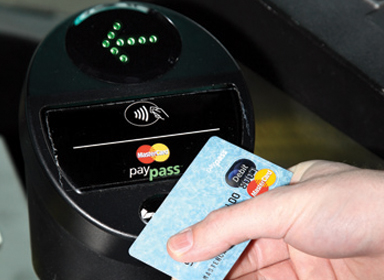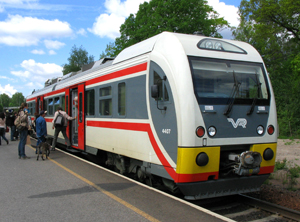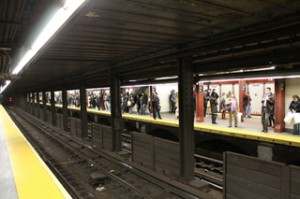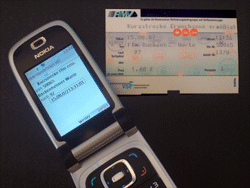A look at the major changes ongoing in US transportation systems payment, such as the transition towards EMV (Europay MasterCard Visa) payment cards, and why transportation operators are in search of solutions to integrate banking cards payments in their mass transit systems through ‘Open Loop’ solutions
by Thierry Spanjaard, Smart Insights
 Mass Transit systems have been in existence for over a century, and their fare media did not evolve much during the first century of their history. Now, new fare media such as contactless cards and tickets are ubiquitous, and transport authorities are permanently looking for means to make fare collections easier, cheaper and more flexible.
Mass Transit systems have been in existence for over a century, and their fare media did not evolve much during the first century of their history. Now, new fare media such as contactless cards and tickets are ubiquitous, and transport authorities are permanently looking for means to make fare collections easier, cheaper and more flexible.
Now, the US are on the path to EMV adoption, with, in the near future, hundreds of millions of people equipped with credit, debit or prepaid cards able to communicate in contactless mode. At the same time, under pressure for a better profitability, and in a move to get away from payment, which is not considered as their core business, transportation operators are in search of solutions to integrate banking cards payments in their mass transit systems.
Such a use is called ‘open loop’ as the payment means is a universal banking cards rather than a “closed loop” transportation operator-issued dedicated card or ticket. US transport authorities and transportation operators have launched multiple pilots, and several projects to integrate banking card as part of their payment solutions in mass transit systems.
Now, next steps to come are the generalization of contactless-enabled banking cards, and the evolution to NFC, the use of a mobile phone as a means of payment. Stakeholders in the transportation service industry envision a future in which payment for mass transit will be performed through an array of means including dedicated transport operator-issued fare media in the form of cards or NFC apps, associated with open loop payment systems including banking cards and NFC handsets.
Authorities vs. operators
In many countries, government delegate their role in organizing transportation means to transport authorities. Transport authorities are generally in charge of decisions on transportation global plans: preferred transport means, investment level, major objectives of the transportation system; subsidies to transportation operators; transportation networks including alignment, stations, etc; in some cases, rolling stock; tariff schedule principles, and often rates; population targets and more.
 Also in many cases, transport authorities are responsible for the investments in transportation networks, either on public or on private funds, or, most often, on a combination of public and private funds. Transport authorities generally decide on population classes who have to benefit from discounted prices on public transport, or who will even travel free. For instance, transport authorities may decide to grant free transport to the elderly, handicapped, youngsters, jobless, etc. populations.
Also in many cases, transport authorities are responsible for the investments in transportation networks, either on public or on private funds, or, most often, on a combination of public and private funds. Transport authorities generally decide on population classes who have to benefit from discounted prices on public transport, or who will even travel free. For instance, transport authorities may decide to grant free transport to the elderly, handicapped, youngsters, jobless, etc. populations.
Transport authorities, or even governments, decide on universal access principles that apply to transport. For instance, transport authorities may decide cash is always to be accepted as a means of payment for transport. Transport authorities delegate to transportation operators the operation of transportation networks. In most cases, an area or a region is served by several transportation operators, who obtain licenses from the transport authorities for each line they operate. Also, there may be different transportation operators for each transportation means: subway, bus, ferry, etc.
A transportation operator is generally responsible for:
- acquiring rolling stock
- hiring employees
- operating the transport means,
- operating the payment system
- providing detailed data to the transport authority.
Transportation operators can be public or private organizations. In most cases, they are subsidized by transport authorities. When several transportation operators serve the same area, or the same population group, most transit authorities demand interoperability between different transportation means to allow for an end-to-end journey with a single payment. This implies an elaborate revenue recognition scheme to attribute its revenue share to each operator.
Revenue structure
Transportation operators cater to a wide variety of populations. In most cases, transportation operators serve a large number of commuters. Commuters typically use the same transportation means, at around the same time, every working (or studies) day. Commuters constitute a loyal set of customers, regardless whether this is by choice or under constraint. For transportation operators, commuters generally constitute the better part of their revenue, as well as the most predicable. For this reasons, commuters are the target of all attentions of transportation operators.
 Typically, transportation operators propose subscriptions to commuters. As these commuters often belong to target populations defined by the transport authority, they are entitled to preferred price plans. At the other end of the spectrum, are the one-time users, who yield a small revenue. One-time users may be visitors or residents who seldom use public transportation systems. Supporting one-time users is generally seen by transportation operators as a constraint imposed by the transport authority. In most cases, transport authorities impose that one time users should be able to use a variety of payment means, including cash, to use a transport system. For this reason, the cost of the fare media, including management cost, may sometimes be higher than the actual cost of travel for one time users.
Typically, transportation operators propose subscriptions to commuters. As these commuters often belong to target populations defined by the transport authority, they are entitled to preferred price plans. At the other end of the spectrum, are the one-time users, who yield a small revenue. One-time users may be visitors or residents who seldom use public transportation systems. Supporting one-time users is generally seen by transportation operators as a constraint imposed by the transport authority. In most cases, transport authorities impose that one time users should be able to use a variety of payment means, including cash, to use a transport system. For this reason, the cost of the fare media, including management cost, may sometimes be higher than the actual cost of travel for one time users.
Coins, tokens, paper tickets
Originally, most transportation systems used coins, tokens or paper tickets as a means of payment. The inconvenience of coins and tokens is that they do not allow to adapt the transport price to the specifics of each user. Paper tickets allow delivering various types of tickets depending in each user, but are cumbersome and expensive to control and allow little automation in revenue recognition.
Magstripe tickets
Then, came ticket with magstripe, whether made out of paper, cardboard, or plastic. Magstripe allows AFC (automated fare collection) and feeding with data a global accounting system to ensure revenue recognition for each operator. Magstripe tickets can be differentiated according to various population needs, allow price variations, and can be reused to cope with the needs of commuters. However, the amount of data on a magstripe is limited, and canceling a magstripe ticket generally means rewiring it, which often means costly reader-writers.
Contactless cards
Contactless cards are now used in most mass transit systems around the world. Contactless cards allow the greatest flexibility: they can contain a lot more data than a magstripe, and include each transit passenger details. Contactless cards are the most flexible solution to cater with the needs of multiple categories of users in a mass-transit system. Contactless card readers are cheaper to install and to maintain than magstripe readers. Automatic fare collection system using contactless cards can feed data directly into a consolidation system to allow revenue recognition between various operators.
NFC
 NFC, or Near-Field Communication is a set of standards for smartphones and similar devices to establish radio communication with each other or with readers by touching or bringing them into close proximity, usually no more than a few centimeters. Typical applications include contactless transactions, including mass transit payment data exchange, and setup of more complex communications. NFC-enabled phone transactions can be used today with existing transport contactless infrastructure. According to the NFC Forum, there are several ways to introduce NFC into a transport system, from simple point-to-point ‘pay-as-you-go’ schemes to more complex implementations that include multiple operators and multiple payment options. The Forum states NFC also supports all forms of ticketing systems, from open (ungated) systems, to controlled entry programs, to completely gated schemes.
NFC, or Near-Field Communication is a set of standards for smartphones and similar devices to establish radio communication with each other or with readers by touching or bringing them into close proximity, usually no more than a few centimeters. Typical applications include contactless transactions, including mass transit payment data exchange, and setup of more complex communications. NFC-enabled phone transactions can be used today with existing transport contactless infrastructure. According to the NFC Forum, there are several ways to introduce NFC into a transport system, from simple point-to-point ‘pay-as-you-go’ schemes to more complex implementations that include multiple operators and multiple payment options. The Forum states NFC also supports all forms of ticketing systems, from open (ungated) systems, to controlled entry programs, to completely gated schemes.
Cost of collection
All aforementioned ticketing systems are perfect for commuters. They allow a link between the fare media and various IT platforms such as the subscriber management system (dealing with commuters), the revenue recognition system etc.
However, the media cost is seen by some transportation operators as prohibitive for one-time users. Smart cards are obviously more expensive than simple paper tickets, and for one-time users, the media cost (with its associated overhead) can sometimes be higher than the fare itself. Some transportation operators have set up systems to issue contactless cards to one-time users for a price including a deposit, and to install systems for users to return their card and collect the deposit at the end of their trip.
Other transportation operators keep on having two different systems for commuters and for one-time users, reserving tokens or disposable magstripe tickets to one time users. However such a solution increases the global cost of operation as employees and or dedicated automats are to be used to sell fare media to these one-time users.
Open loop
The pressure of transport authorities and the evolutions of mass transit operators leads them to try and cut costs wherever possible in order to concentrate on their core mission: provide transport services to passengers. Many of them now consider their role is not to collect money, and that they are more efficient in their mission is some other entities takes care of the fare collection. After investigating multiple options, several transit operators realized that they can be considered as just another merchant. Thus, why not collecting the cost of a ticket in a one-off payment transaction?
The idea behind open loop is to take advantage of the existing payment means infrastructure. When most users are equipped with a payment means that can be accepted on an AFC (automated fare collection) gate, why not adapt the AFC gate to perform payment transactions. Under the open loop concept, AFC gates perform a regular payment transaction, just like any merchant, at the gate given the passenger is equipped with a contactless debit or credit card.
Under the open loop concept, the transit operator does not need to care about issuing fare media. Debit and credit cards are issued by financial institutions or payment service providers, and are open by nature. Debit and credit cards are now widely accepted by cardholders, and in most countries, bancarization rate is sufficiently high to consider a banking card as an almost universal payment means. Payment transactions are easy to implement thanks to an extensive infrastructure, in terms of payment systems, concentrators, payment processors, etc. Low value payments, typically under US$ 25 (EUR 19), are now generally accepted without any cardholder verification method such as PIN or signature.
Also printing transaction receipts are now considered optional. Being large merchants, transportation operators can negotiate fair commission levels with transaction acquirers. The ongoing migration to EMV in the US is a highly favorable factor. By 2015, the date set for the liability shift, most US cardholders will be equipped with smart cards, most probably with dual interface, thus enabling contactless payment. According to IMS Research, dual interface cards and contactless cards will account for over 40% of the payment cards in issuance in the US by 2017.
Inconveniences
The open loop concept fits with the need for payment for one-time users equipped with a contactless banking card (credit, debit or prepaid). When transport authorities impose that cash is to be accepted as a means of payment, open loop does not provide a full answer. Also, open loop does not address the needs of the unbanked population (8.2% of households in the US, according to the FDIC). This can be solved by having tellers or automats selling prepaid cards, valid for a few trips, or even down to one trip to cater with this demand.
For subscribers, there is a need to store the subscription details in the card. As credit, debit, and prepaid cards are owned by financial institutions, this would mean having a specific agreement between the transportation operator and the financial institution, which is hardly feasible for all financial institutions and all transportation operators. Open loop has been facing criticism saying that it would give banks access to data about where and when people are traveling to different parts of a city.
A major revolution
American transportation authorities and mass transit operators are on the verge of a major evolution in their payment systems. Most operators have set up fare systems perfectly adapted to commuters needs, but are still facing the imbalance created by one-time users who represent both a low income and a high level of expense for the operator. Now, the US payment community is transitioning towards EMV (Europay MasterCard Visa) payment cards, bringing a new solution to onetime users issue.
Once the US market will have completed the EMV migration (i.e. all credit and debit cards will be smart cards), Open Loop will become a standard solution for mass transit payment, achieving one more step to displace cash.
